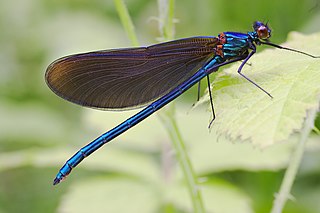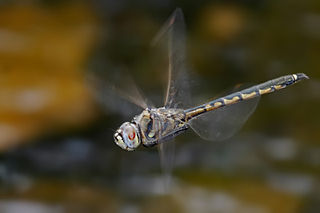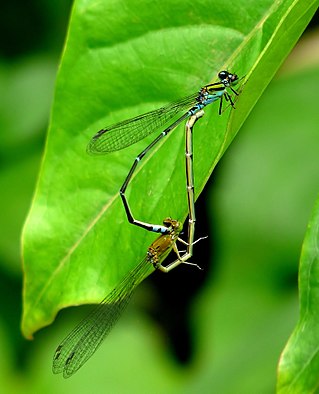
The chasers, darters, skimmers and perchers and their relatives form the Libellulidae, the largest family of dragonflies. It is sometimes considered to contain the Corduliidae as the subfamily Corduliinae and the Macromiidae as the subfamily Macromiinae. Even if these are excluded, there remains a family of over 1000 species. With nearly worldwide distribution, these are almost certainly the most often seen of all dragonflies.

Ischnura aurora, the gossamer damselfy or golden dartlet and also known as the aurora bluetail, is a species of damselfly in the family Coenagrionidae.

The Platycnemididae are a family of damselflies. They are known commonly as white-legged damselflies. There are over 400 species native to the Old World. The family is divided into several subfamilies.
Aethiothemis is a small genus of dragonflies in the family Libellulidae.

Agriocnemis is a genus of damselfly in the family Coenagrionidae. Agriocnemis is distributed widely across Africa, South-east Asia, Indonesia, Australia and islands in the Pacific. They are small insects, commonly known as wisps.

Argiocnemis is a genus of damselfly in the family Coenagrionidae. Species of Argiocnemis are generally small to medium-sized damselflies, darkly coloured with pale markings. They occur in Africa, Indian Ocean islands, South-east Asia, New Guinea and Australia.

Calopteryx is a genus of large damselflies belonging to the family Calopterygidae. The colourful males often have coloured wings whereas the more muted females usually have clear wings although some develop male (androchrome) wing characteristics. In both sexes, there is no pterostigma.

Ceriagrion is a genus of damselfly in the family Coenagrionidae. Species of Ceriagrion are small to medium size, generally brightly coloured damselflies. They are found across the Old World, Africa, Asia and Australia.

Hemicordulia is a genus of dragonfly in family Corduliidae. It occurs in Africa, southern Asia, Australasia and Pacific Islands such as the Bonin Islands, Fiji and French Polynesia. Species of Hemicordulia are small to medium-sized dragonflies, coloured black or metallic, with yellow.

Indolestes is a genus of damselflies in the family Lestidae. Species of Indolestes can be medium-sized, dull coloured dragonflies. They are found from India through Asia, Australia and the Pacific.

Pseudagrion is the largest genus of damselfly in the family Coenagrionidae, with over 140 species. Its range includes most of Africa, much of Asia, and Australia. Africa holds most of the diversity with almost 100 species. It has occupied most of the freshwater habitats in its range, and dominates damselfly communities in habitats as different as desert pools, equatorial rainforests and montane streams.

Teinobasis is a genus of damselflies in the family Coenagrionidae. Species occur in south-eastern Asia, Indonesia, Solomon Islands and Micronesia; one species, Teinobasis rufithorax, is found in Australia.

Tramea is a genus of dragonflies in the family Libellulidae, the skimmers and perchers. Species of Tramea are found in tropical and subtropical regions around the globe. They typically have colored bases to their otherwise translucent hindwings. In particular when they fly, this creates the impression of their carrying bags at the start of their abdomens. They are known commonly as saddlebags or saddlebags gliders.

Zygonyx is a genus of dragonflies in the family Libellulidae. They are commonly known as cascaders because of their preference for living beside waterfalls and flying through the spray. They lay their eggs in wet dangling roots.

Agrionoptera is a genus of dragonflies in the family Libellulidae. Species of Agrionoptera are found across India, Southeast Asia and the Pacific.

Anax indicus is a species of dragonfly in the family Aeshnidae. It is found in India, Nepal, Pakistan, Sri Lanka, and Thailand.

Cratilla lineata, the line forest-skimmer, emerald-banded skimmer or pale-faced forest-skimmer, is a species of dragonfly in the family Libellulidae. It is found in many Asian countries.

Zygonyx iris, the emerald cascader or iridescent stream glider, is a species of dragonfly in the family Libellulidae. It is widespread in many Asian countries.
Huonia is a genus of dragonfly in the family Libellulidae. Species of this genus are found in Indonesia, New Guinea and Australia.

Maurits Anne Lieftinck informally Maus Lieftinck was a Dutch entomologist who specialized in the Odonata, particularly in Southeast Asia, working from the Bogor Museum where he worked for a significant period.


















